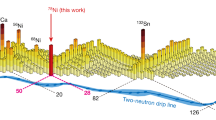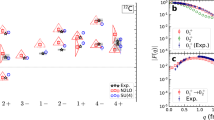Abstract
Nuclei undergoing fission can be described by a multi-dimensional potential-energy surface that guides the nuclear shape evolution—from the ground state, through intermediate saddle points and finally to the configurations of separated fission fragments. Until now, calculations have lacked adequate exploration of the shape parameterization of sufficient dimensionality to yield features in the potential-energy surface (such as multiple minima, valleys, saddle points and ridges) that correspond to characteristic observables of the fission process. Here we calculate and analyse five-dimensional potential-energy landscapes based on a grid of 2,610,885 deformation points. We find that observed fission features—such as the distributions of fission fragment mass and kinetic energy, and the different energy thresholds for symmetric and asymmetric fission—are very closely related to topological features in the calculated five-dimensional energy landscapes.
This is a preview of subscription content, access via your institution
Access options
Subscribe to this journal
Receive 51 print issues and online access
$199.00 per year
only $3.90 per issue
Buy this article
- Purchase on Springer Link
- Instant access to full article PDF
Prices may be subject to local taxes which are calculated during checkout







Similar content being viewed by others
References
Meitner, L. & Frisch, O. R. Disintegration of uranium by neutrons: A new type of nuclear reaction. Nature 143, 239–240 (1939).
Bohr, N. & Wheeler, J. A. The mechanism of fission. Phys. Rev. 56, 426–450 (1939).
Hahn, O. & Strassmann, F. Über den Nachweiss und das Verhalten der bei der Bestrahlung des Urans mittels Neutronen entstehenden Erdalkalimetalle. Naturwissenschaften 27, 11–15 (1939).
Frankel, S. & Metropolis, N. Liquid-drop model of fission. Phys. Rev. 72, 914–925 (1947).
Strutinsky, V. M. Shell effects in nuclear masses and deformation energies. Nucl. Phys. A 95, 420–442 (1967).
Strutinsky, V. M. Shells in deformed nuclei. Nucl. Phys. A 122, 1–33 (1968).
Nilsson, S. G. et al. On the nuclear structure and stability of heavy and superheavy elements. Nucl. Phys. A 131, 1–66 (1969).
Pashkevich, V. V. The energy of non-axial deformation of heavy nuclei. Nucl. Phys. A 133, 400–404 (1969).
Möller, P. & Nilsson, S. G. The fission barrier and odd-multipole shape distortions. Phys. Lett. 31B, 283–286 (1970).
Brack, M. et al. Funny hills: The shell-correction approach to nuclear shell effects and its applications to the fission process. Rev. Mod. Phys. 44, 320–405 (1972).
Nix, J. R. Calculation of fission barriers for heavy and superheavy nuclei. Annu. Rev. Nucl. Sci. 22, 65–120 (1972).
Möller, P., Nix, J. R., Myers, W. D. & Swiatecki, W. J. Nuclear ground-state masses and deformations. Atom. Data Nucl. Data Tables 59, 185–381 (1995).
Aboussir, Y., Pearson, J. M., Dutta, A. K. & Tondeur, F. Nuclear-mass formula via an approximation to the Hartree-Fock method. Atom. Data Nucl. Data Tables 61, 127–176 (1995).
Möller, P. & Nix, J. R. Potential-energy surfaces for asymmetric heavy-ion reactions. Nucl. Phys. A 281, 354–372 (1977).
Möller, P., Nix, J. R. & Swiatecki, W. J. Calculated fission properties of the heaviest elements. Nucl. Phys. A 469, 1–50 (1987).
Möller, P., Nix, J. R. & Swiatecki, W. J. New developments in the calculation of heavy-element fission barriers. Nucl. Phys. A 492, 349–387 (1989).
Armbruster, P. Nuclear structure in cold rearrangement processes in fission and fusion. Rep. Prog. Phys. 62, 465–525 (1999).
Britt, H. C., Wegner, H. E. & Gursky, J. C. Energetics of charged particle-induced fission reactions. Phys. Rev. 129, 2239–2252 (1963).
Konecny, E., Specht, H. J. & Weber, J. in Proc. Third IAEA Symp. Phys. Chem. Fission Vol. II, 3–18 (International Atomic Energy Agency, Vienna, 1974).
Ohtsuki, T., Nakahara, H. & Nagame, Y. Systematic variation of fission barrier heights for symmetrical and asymmetric mass divisions. Phys. Rev. C 48, 1667–1676 (1993).
Nagame, Y. et al. Bimodal nature of low energy fission of light actinides. Radiochim. Acta 78, 3–10 (1997).
Möller, P. & Iwamoto, A. Realistic fission saddle-point shapes. Phys. Rev. C 61, 47602-1–4 (2000).
Möller, P., Nix, J. R. & Kratz, K.-L. Nuclear properties for astrophysical and radioactive-ion-beam applications. Atom. Data Nucl. Data Tables 66, 131–343 (1997).
Mamdouh, A., Pearson, J. M., Rayet, M. & Tondeur, F. Large-scale fission-barrier calculations with the ETFSI method. Nucl. Phys. A 644, 389–414 (1998).
Hulet, E. K. et al. Bimodal symmetrical fission observed in the heaviest elements. Phys. Rev. Lett. 56, 313–316 (1986).
Hoffman, D. C. & Hoffman, M. M. Post-fission phenomena. Annu. Rev. Nucl. Sci. 24, 151–207 (1974).
Dematte, L., Wagemans, C., Barthelemy, R., Dhondt, P. & Deruytter, A. Fragments' mass and energy characteristics in the spontaneous fission of Pu-236, Pu-238, Pu-240, Pu-242 and Pu-244. Nucl. Phys. A 617, 331–346 (1997).
Schmidt, K.-H. et al. Relativistic radioactive beams: A new access to nuclear-fission studies. Nucl. Phys. A 665, 221–267 (2000).
Bolsterli, M., Fiset, E. O., Nix, J. R. & Norton, J. L. New calculation of fission barriers for heavy and superheavy nuclei. Phys. Rev. C 5, 1050–1075 (1972).
Krappe, H. J., Nix, J. R. & Sierk, A. J. Unified nuclear potential for heavy-ion elastic scattering, fusion, fission, and ground-state masses and deformations. Phys. Rev. C 20, 992–1013 (1979).
Möller, P. & Iwamoto, A. Macroscopic potential-energy surfaces for arbitrarily oriented, deformed heavy-ions. Nucl. Phys. A 575, 381–411 (1994).
Möller, P. & Randrup, J. New developments in the calculation of β-strength functions. Nucl. Phys. A 514, 1–48 (1990).
Kratz, K.-L., Bitouzet, J.-P., Thielemann, F.-K., Möller, P. & Pfeiffer, B. Isotopic r-process abundances and nuclear-structure far from stability: implications for the r-process mechanism. Astrophys. J. 403, 216–238 (1993).
Kudyaev, G. A., Ostapenko, Yu. B. & Smirenkin, G. N. Thresholds and saddle shapes in symmetric and asymmetric fission in the vicinity of Ra. Sov. J. Nucl. Phys. 45, 951–958 (1987).
Zhao, Y. L. et al. Experimental verification of two deformation paths in the mass division process of actinides. J. Alloys Comp. 271, 327–330 (1998).
Meitner, L. Fission and nuclear shell model. Nature 165, 561 (1950).
Hayes, B. Dividing the continent. Am. Sci. 88, 481–485 (2000).
Acknowledgements
The calculations on which the results in this paper are based were carried out on the cluster of 4 Alpha processors at the TANDEM accelerator in JAERI in the winter of 1998–99 and subsequently on the AVALON cluster of 140 Alpha processors at Los Alamos. This research is supported by the US DOE.
Author information
Authors and Affiliations
Corresponding author
Rights and permissions
About this article
Cite this article
Möller, P., Madland, D., Sierk, A. et al. Nuclear fission modes and fragment mass asymmetries in a five-dimensional deformation space. Nature 409, 785–790 (2001). https://doi.org/10.1038/35057204
Received:
Accepted:
Issue Date:
DOI: https://doi.org/10.1038/35057204
This article is cited by
-
Comparison of different nuclear potentials to predict the alpha decay half-lives
Indian Journal of Physics (2024)
-
Impact of nuclear structure of correlated pairs of fission fragments in mass distribution spectra of heavy-ion fusion–fission reactions
Pramana (2024)
-
Microscopic theory for nuclear fission dynamics
AAPPS Bulletin (2022)
-
Theoretical analysis of long-lived radioactive waste in pressurized water reactor
Nuclear Science and Techniques (2021)
-
Decay of dinuclear systems formed from dubnium
Pramana (2021)
Comments
By submitting a comment you agree to abide by our Terms and Community Guidelines. If you find something abusive or that does not comply with our terms or guidelines please flag it as inappropriate.



